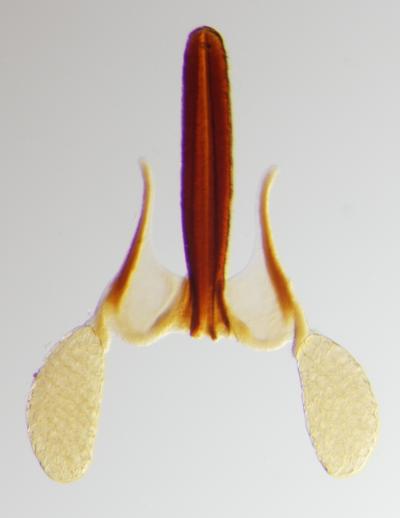First evidence of plants evolving weaponry to compete in the struggle for selection

This is an example of the horned pollinaria found in South American milkweed. Credit: Andrea Cocucci
The team, led by Dr. Andrea Cocucci from the Instituto Multidisciplinario de Biologia Vegetal of Argentina, studied a species of milkweed (Apocynaceae), found in tropical climates.
While plants do not mate like animals, but rather reproduce via pollinators such as insects or birds, competition between individuals to exploit those pollinators can result in confrontation between the plants.
Milkweed reproduce by hooking sacs of pollen grains, known as pollinia, to the bodies of birds and other pollinators, which can be unwittingly dropped into another flower to complete pollination.
It is possible for multiple pollinarium to become entangled together due to the limited number of attachment points on the pollinator, and this Dr. Cocucci's team believe, is the source of confrontation.
The team studied the South America milkweed genus Oxypetalum and found horn-like structures on the pollinia sacs which have no obvious biological use. The paper suggests that these horns are used to prevent the sacs from being hooked together with pollinia from other parent plants.
“Our results suggest that neither self-propulsion nor well-developed sensory perception are required for sexual selection to take place through intrasexual struggles,” said Dr. Cocucci.
“Apparently, only physical contact is enough to influence the mating success of competitors and to promote the evolution of defensive and attack weaponry.”
Media Contact
More Information:
http://www.wiley.comAll latest news from the category: Life Sciences and Chemistry
Articles and reports from the Life Sciences and chemistry area deal with applied and basic research into modern biology, chemistry and human medicine.
Valuable information can be found on a range of life sciences fields including bacteriology, biochemistry, bionics, bioinformatics, biophysics, biotechnology, genetics, geobotany, human biology, marine biology, microbiology, molecular biology, cellular biology, zoology, bioinorganic chemistry, microchemistry and environmental chemistry.
Newest articles

High-energy-density aqueous battery based on halogen multi-electron transfer
Traditional non-aqueous lithium-ion batteries have a high energy density, but their safety is compromised due to the flammable organic electrolytes they utilize. Aqueous batteries use water as the solvent for…

First-ever combined heart pump and pig kidney transplant
…gives new hope to patient with terminal illness. Surgeons at NYU Langone Health performed the first-ever combined mechanical heart pump and gene-edited pig kidney transplant surgery in a 54-year-old woman…

Biophysics: Testing how well biomarkers work
LMU researchers have developed a method to determine how reliably target proteins can be labeled using super-resolution fluorescence microscopy. Modern microscopy techniques make it possible to examine the inner workings…





















